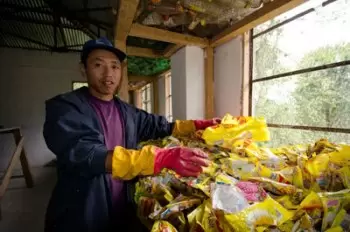The story of restoration of a hill in Sikkim

17-August-2012
Vol 3 | Issue 33
Text and photographs by Shailendra Yashwant
From Dzongu on the northeast borders of the Khangchendzonga biosphere reserve I proceeded southwest to Yuksom in the Ratong Chu valley, the official entry point to the Khangchendzonga national park.
Lorded over by the mighty and most sacred Mount Khangchendzonga, the third highest peak (8,586 m) in the world, Yuksom at 1,780m sits comfortably at the ankles of the great mountain, nestled in forests of broad-leaved oak, birch, maple, chestnut, magnolia, rhododendron, silver fir, ash and alder trees.
 |
|
Khongchengdzonga mountain range (Photos: Shailendra Yashwant)
|
Yuksom, in Lepcha language means the meeting place of three learned monks, who chose the first king, the Chogyal, to establish the Buddhist kingdom of Sikkim.
Yuksom was the first capital of Sikkim and the village is an important historical destination littered with 17th-century ruins and some of the earliest Buddhist gompas of the region blessed by the great Rinpoche aka Guru Padmasambhava.
Two years after India annexed Sikkim in 1975, about 850 sq km of the national park was notified by the Sikkim government in 1977.
Today the national park and the contiguous biosphere reserve occupy 1,784 sq km, almost 1/4th of Sikkim, and are home to an exceptional representation of flora and fauna from the trans-Himalayan landscapes of the east.
Although 90% of the park is above 3,000 metres -- 34% of this under glaciers and perpetual snow -- wide altitudinal and eco-climatic variations have resulted in the presence of 14 forest types in the park.
The park is home to the elusive snow leopard, the shy red panda, and the much-sought- after musk deer, Himalayan tahr, besides scores of endangered and endemic herbivores and carnivores and a rich variety of avi-fauna.
The first tourist lodge in Yuksom, Dzongri La was built in 1980. By 1985 the number of visitors began multiplying. From 2,000 visitors in 1990 the tourist numbers almost doubled to 4,500 in 2005.
Besides being the main entrance to the national park, Yuksom is also a trailhead for the Dzongri, Thangsing, Goecha La, Khangchengdzonga base camp treks.
The Himalayan Mountaineering Institute (HMI) of Darjeeling began using the Dzongri trail for its training camps.
The trekking boom that followed the relaxation of norms for inner line permits for foreigners and Indian nationals in 1994 brought in foreign trekking companies from Nepal and India who in turn started bringing in their staff, cooks and porters for this first time ever easy access to Khangchendzonga base camp.
Trees were being cut for cooking, bath water and bonfires to warm the freezing trekkers, and slowly garbage of all variety piled up, detergents and oils polluting the waterfalls and glacial streams.
Biopiracy and poaching were increasing and in the absence of strict policing the national park which covers a quarter of Sikkim state, was heading for a disaster. Partly in reaction to this invasion but more out of concern for the immediate environment of Yuksom, local community members came together to form the Khangchendzonga Conservation Committee (KCC) in 1997.
The organisation comprises of community members and stakeholders in tourism enterprises working for conservation of natural and cultural resources, coordinated by the Sikkim forest department.
The key issues identified for immediate action by the KCC were: overgrazing in the park by yaks and sheep, habitat destruction caused by HMI training camps at Rathong glacier, garbage management within the national park, relocation of Tshoka village inside the park and finally, ensuring that the maximum benefits from tourism go to the local communities.
In the first three-year project with The Mountaineering Institute (TMI), KCC was a guinea pig to test the APPA approach (appreciate, participate, plan, act) to build community participation in protecting the KNP biosphere.
All KCC members agree that the approach worked in raising awareness of community members and rebuilding pride in their natural and cultural heritage.
"I learnt a lot in those three years. On the one hand I realised that people were coming to Yuksam to appreciate its natural beauty and on the other, linking conservation to tourism was like a double-edged knife, if not used properly it will harm the user. By now almost 80% of households in our village were dependent on tourism in some way or other.
“I was aware that if a natural disaster was to occur due to loss of our forests -- like landslides, floods -- it is our people who will suffer. This is when I understood that if we don't conserve biodiversity the fledgling tourism industry will also collapse, leaving us with nothing," says Tshering Uden, CEO and treasurer of KCC.
By 1995 climate change had touched the lives of the people of Yuksom for the first time. The news that Rathong glacier had started receding and Doodh Pokhri, another Himalayan peak, had started crumbling was received grimly by the villagers.
.webp) |
|
Tshering Uden, CEO of KCC
|
Meanwhile, the rest of India had discovered cheap airlines and package tours. By 1999, hordes of domestic tourists began discovering destinations around Yuksam like Pelling, with its magnificent view of the Khangchendzonga range, the Khoeochapheri lake aka the Wishing Lake on the outskirts of Yuksom and the Khangchendzonga waterfalls en route to the popular Tashiding monastery. The tourism industry was set to become the most clear and present danger for Yuksom and Uden.
One of the earliest interventions by KCC included a handbook for porters to raise awareness about ecological management during treks. The delightful little handbook published in the local language -- a mix of Nepali, Hindi and local dialects -- is a crash-course for porters and support staff.
Information ranging from the importance of conservation and waste management to bird-spotting techniques and how to identify important flora and fauna is packed in the little booklet which is a big hit with the porter community.
The forest department took the lead with the phased eviction of permanent yak and sheep settlements followed by setting up of a code of conduct together with HMI to ban the use of firewood within KNP, bring back the garbage dumped by HMI over 30 years, drastically reduce the courses and number of trainees, and make environmental orientation of the trainees mandatory at Yuksom.
This slowed down and finally brought to an end the indiscriminate exploitation of high-altitude shrubs and trees for firewood, overgrazing of medicinal plants and dumping of garbage in the sacred park.
As with all good intentions, initial moves won more support and the means to build a comprehensive programme to clean up and keep the KNP clean.
The Sikkim forest department further delivered on their commitment for better waste management in the park by allowing KCC to design and enforce a system for all trekking groups to manage waste generation, segregation and recycling as part of the park's entry and exit procedures.
The idea is so good that due to lack of capacity at KCC, when I visited in May 2012, KNP receptionist Doma Tshering Lepcha had voluntarily taken on the task of filling the waste registration form for visitors.
A row of eight massive garbage bins at the entry checkpoint were installed and a segregation and waste recycling centre was set up a stone’s throw from it.
Uden took me on a tour of the waste recycling centre. “We are always short of funds which affects our capacity but we have managed to keep two staff members for the waste segregation and recycling unit and the waste paper-making programme.” She introduced me to Dalbahadur Subba and Pentuk Bhutia with pride.
 |
|
Dalbahadur Subba retrieves the garbage and segregates it for KCC
|
Dalbahadur brings back the segregated garbage from the KNP checkpoint, washes and dries it and neatly packs it to send to recycling units in the plains. Pentuk who has received training in paper-making, runs the paper-making unit where he is currently pressing paper for a government order from a mix of pulp of weed and wastepaper. Both boys from Yuksam, like all the boys in this village, grin and pose easily for pictures.
It is difficult not to be impressed, for within 15 years, KCC has successfully pioneered a sustainable tourism programme that is run with compassion, pragmatism, bold vision and a pinch of magic that is inevitable when a few good people come together to do good things.
The tourists are increasing every day, despite the earthquake of September 2011. Plans are afoot to decongest the Dzongri trek by opening 184 km of trails with 16 campsites to create four international-standard trekking routes.
On paper (Forestry and Environment Mission, Sikkim 2015), the state has committed itself to promoting ecotourism which will provide income-generation opportunities to local communities living in forest fringe areas and ensuring that the impact of developing ecotourism does not damage the environment.
But unless it builds capacity like in Yuksom, the current rush of Indian tourists to Sikkim will change the face of this magnificent vista. Already Gangtok looks like Darjeeling, a mountainside slum.
On my last day in Yuksom, walking up to Hungri Gompa, Sikkim’s oldest monastery, on the border of the national park, I stopped at a small stream to quench my thirst and refill my water bottle when it suddenly occurred to me that there are very few places left on the planet where you can drink water as clean as this for free!
(Shailendra Yashwant is an independent photojournalist documenting the impact of development on the fragile ecology and indigenous people of Northeast India.) - Infochange News & Feature














